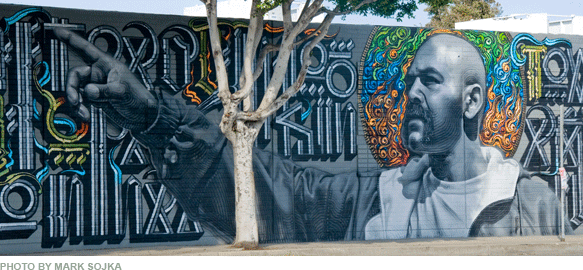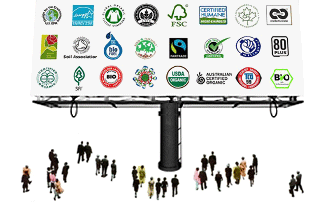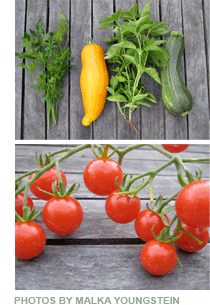I’m excited to deliver the 2nd issue of “The Stand,” and to share the sage advice from sustainability business consultant, Carlos Lawrence of AgNet Systems and a delicious pasta recipe from the organic kitchen of Eco Maven, Malka Youngstein. There’s a yummy pasta recipe to boot! On the opposite end of the spectrum, it’s my pleasure to present world renown graffiti artists Mac + Renta who recently provided our home town of Culver City with their collaborative talents and the positive messaging behind their contemporary street art. And lastly, give us a shout on our new blog, “What inspires you?” We’d love to hear what turns you on or take a moment to read what’s been inspiring others who have contributed already. It’s contagious, this thing called inspiration!
Sincerely,
Stan
|
|
 |
|
 |
EDG’s CEO, Stan Evenson, and President, Tricia Evenson, with 60 years of combined brand strategy and design experience, will personally consult with you and your team regarding your company, product, and/or service’s current branding.
*Travel expenses not included. Call 310-204-1995 for details. |
|
|
|
GRAPHAIDS ADDS DIGITAL TO THEIR ARTIST PALETTE
 If you’re a designer, art director, fine artist, architect, or craftsman, who has lived in Southern California for any length of time, you probably know “Graphaids.” You might also remember their oval shaped logo encompassing seven artist tools running diagonally, many now obsolete. Remember rapidographs and burnishers? This logo represented Graphaids art supply store for nearly 40 years. The family run business, which started at one location, has successfully grown to six stores from Long Beach to Agoura Hills and everywhere in between serving design firms, ad agencies, entertainment studios, as well as local artists. Graphaid’s President, Chip Festa, recognizing their identity wasn’t keeping up with the times saw the need to refresh the logo, especially since they were adding digital equipment and printing services to their capabilities. “I’ve known Stan and his company as being one of the top design firms in Los Angeles in addition to being a long-time loyal customer of Graphaids. This made it a perfect fit for us to work together and we’re thrilled with the results.” If you’re a designer, art director, fine artist, architect, or craftsman, who has lived in Southern California for any length of time, you probably know “Graphaids.” You might also remember their oval shaped logo encompassing seven artist tools running diagonally, many now obsolete. Remember rapidographs and burnishers? This logo represented Graphaids art supply store for nearly 40 years. The family run business, which started at one location, has successfully grown to six stores from Long Beach to Agoura Hills and everywhere in between serving design firms, ad agencies, entertainment studios, as well as local artists. Graphaid’s President, Chip Festa, recognizing their identity wasn’t keeping up with the times saw the need to refresh the logo, especially since they were adding digital equipment and printing services to their capabilities. “I’ve known Stan and his company as being one of the top design firms in Los Angeles in addition to being a long-time loyal customer of Graphaids. This made it a perfect fit for us to work together and we’re thrilled with the results.” We knew change wasn’t an easy thing for the Festa family. However, after presenting our concepts in an evolutionary way we finally convinced the majority to see the benefit of going with a brand new image rather than simply refreshing what they already had. The result is a very graphic and bold “G.” This new mark represents both digital and fine art and succinctly communicates their diverse products from one end of the spectrum to the other. A stationery program, vehicle wraps, interior and exterior store signage were also created for their corporate identity program. So now walk into any Graphaids store and you’ll be greeted with that same family friendly atmosphere as you have for the last 39 years, with a contemporary brand that also aligns their steadfast values and mission, and of course, their move into the digital art age. |
|
 |
|
THE MAC + RETNA SHOW
Graffiti With a Good Intention or Whose Wall is it Anyway?
Recently, Graphaids had a unique opportunity to participate in the annual Culver City Art Walk and offered up their La Cienega/West LA store front as a proverbial “canvas.” Graphaids enlisted two well known graffiti muralists, Mac + Retna, whose collaborative work has had worldwide prominence in recent years and enrolled them into creating a true masterpiece on the side of their store. As you can see by the results, their six-day process mural using 120 cans of spray paint now adorns Graphaids with a truly striking work or art.
The characters in the passage read, “So today I’m trying to change a few things to rectify the situation from my past. So today I’m looking towards the future of our youth.” The letterforms have been appropriated and manipulated by Retna to create a visually stimulating and complex typography. Taking inspiration from Arabic calligraphy and Egyptian hieroglyphics to urban street culture, Retna has established a distinct and intricate alphabet all his own.
The figure in the mural is a man by the name of Ralph Woodruff, who Mac + Retna met while painting another mural located on Skid Row in Downtown Los Angeles. The text is actually quoted from a conversation they had with Ralph. Mac and Retna felt Ralph had a great attitude and outlook on life so they wanted to share his views with the community.
Mac + Retna first met ten years ago when painting side by side at an art event and then were re-introduced by a mutual friend a few years later. They have been working and collaborating on murals together for the past five years. Mac is best known for his photo realistic portraits combined with his graffiti embellishments and Retna for his stylized text. Despite contrasting backgrounds and artistic styles, they have formed a strong synergy that has proven to be highly successful.
The mural is a message of hope for anyone trying to right their wrongs and also serves as a tribute to the community and this message resonates with the artists personally. Because graffiti tends to have a negative connotation, and although they themselves may have fueled that stereotype in the past, Mac + Retna are approaching their craft as an authentic and positive expression of who they are and a way to give back to humanity versus simply defacing property. So if you happen to be driving on La Cienega Boulevard in Culver City between Washington and Fairfax boulevards, you’ll want to stop in order to thoroughly enjoy this new LA landmark on the side of the Graphaids building. |
|
|
BRINGING YOUR GREEN PRODUCTS TO MARKET
by Carlos Lawrence
 Whether you have identified a highly profitable sector in organic products that you want to bring to market or are looking to make a difference with your sourcing, you will need to navigate the challenging waters of organics and green food marketing. This will include choosing the standards for your message, completing the supply chain, and designing a brand message that connects with consumers. Whether you have identified a highly profitable sector in organic products that you want to bring to market or are looking to make a difference with your sourcing, you will need to navigate the challenging waters of organics and green food marketing. This will include choosing the standards for your message, completing the supply chain, and designing a brand message that connects with consumers.The web site ecolabelindex.com has a comprehensive list of over 300 ecolabels or “green stickers” for food and consumer products. Ecolabels are a form of sustainability measurement, intended to make it easy to take environmental concerns into account when shopping. Choosing which to pursue for your product requires both an understanding of your market and the requirements to acquire the mark. Some are legally regulated such as the term “Organic.” Many other standards are strictly voluntary but can carry strong market value. You will need a good sense of the value an ecolabel brings to your brand before moving to the supply chain as there can be significant costs to bring these standards to your product. For nationally regulated standards like Organic, you will also need to identify your target countries.
Organic certification is an international web of standards that can be often confusing and conflicting to implement. Voluntary standards such as Fair Trade often have costs and audits at each link of the supply chain. These costs can significantly increase your price to market. Working with your Quality Assurance department or consultant to find the right standards can be important in mitigating these costs by choosing standards with good supply or are reasonable to acquire.
If you do end up in the position of having to certify a supply chain, consider partnering with the supplier to get your name on the certification. Getting a group of remote growers certified organic can be quite costly to install and maintain. If you add a social responsibility standard to that, a significant marketing investment can arise before you even consider certifying your finished product. This means if you are committing to paying a higher price for certified products, or financing a supply chain’s certification, to make sure the margin is over your conventional competitors. I recently recommended a clothing marketer to certify only the cotton, because the supply chain was full of government controlled enterprises that would be too costly to certify. “Made with Organic Cotton” was the most cost effective message for the size of venture, and it really benefited the farmers which is the most socially responsible aspect.
Once you have completed the chain, carefully select how you go about naming, branding, and marketing your message. Companies such as Tom’s of Maine and Ben & Jerry’s did a stellar job sending out green messages before the US organics law was even in place. There are great field tools to connect suppliers to your retail brand. Many organic and socially responsible brands are using the traceability in these supply chains to collect anecdotes from growers about the origins of their products. To instill your message in your company and brand, get your staff out and into the field. Back in the 80s, we were taking all our coffeehouse managers to meet coffee growers in remote growing regions, bringing stories of the coffeehouse customers to the growers and from the growers to the coffeehouses. Also, dig deep to identify what you are truly passionate about and convey that message to your employees, customers, suppliers, investors and your colleagues alike. When you are authentically passionate and relate to people, you will inspire them with your excitement, energy, and enthusiasm—all of the qualities people love to see in others. And if people are relating to you, they're more likely to back your vision and do business with you. I only wish we had brought in a great branding firm at the beginning to help us develop our vision for our coffeehouses with a distinctive name and brand identity that our staff, customers and suppliers could say and recognize easily. Starbucks started their growth about the same time my company did, and it’s obvious who won that market battle.
About Carlos Lawrence: Carlos founded a coffeehouse chain in 1987 that grew to two dozen locations throughout the central US. Upon selling to his partners, he worked in the supply chain for many years organizing coffee farmers to get organic certification and set up markets in the US. After experiencing the myriad of problems in certification, he began working with certification agencies and producers on streamlining the certification process for issues like organics, GAP (good agricultural practice), and food safety. Learn more at agnetsystems.com.
|
|
|
ENJOYING LATE-SUMMER PRODUCE
by Malka Youngstein
  As summer begins to wind down and we head towards autumn, now is a wonderful time to take advantage of summer’s bountiful vegetables while they are at their peak. If you are fortunate enough to have your own vegetable garden, you may have the makings for this pasta dish in your own yard. If not, I recommend a trip to your local farmer’s market to gather the ingredients for this light but very satisfying pasta dish. As summer begins to wind down and we head towards autumn, now is a wonderful time to take advantage of summer’s bountiful vegetables while they are at their peak. If you are fortunate enough to have your own vegetable garden, you may have the makings for this pasta dish in your own yard. If not, I recommend a trip to your local farmer’s market to gather the ingredients for this light but very satisfying pasta dish.LATE-SUMMER PASTA WITH ZUCCHINI AND TOMATOES
(makes 4 main-course or 6 first-course servings)
4 medium zucchini, cut into ½" dice
5 garlic cloves, minced
4 tablespoons, extra-virgin olive oil
1/4 cup, flat leaf (Italian) parsley leaves, coarsely chopped
About 10 fresh basil leaves, coarsely chopped
2 teaspoons fresh thyme leaves chopped
1 1/2 cups cherry tomatoes, stems removed and halved
1 lb dried orecchiette or similar shaped pasta
1/2 cup, grated Parmesan cheese
Salt and freshly ground pepper
Pinch of red pepper flakes (optional)
Cook pasta in large pot of boiling salted water until tender but still firm to bite, stirring occasionally.
While the pasta cooks, heat 2 tablespoons of oil in a heavy large skillet over medium-high heat. Add zucchini and sauté until it softens and starts to turn golden. Add thyme and garlic and cook, stirring for 3 minutes. Then add the tomatoes and cook for about 2 more minutes until they begin to soften.
Drain pasta; return to pot or a serving bowl. Add vegetables, the remaining olive oil, parsley and basil and toss to combine. Season to taste, preferably with kosher or sea salt and fresh ground pepper. Add some red pepper flakes if you want a little more spice. Sprinkle with cheese and serve immediately.
Wine Tip: This dish is lovely with either a Pinot Grigio or a Sauvignon Blanc.
About Malka Youngstein: After working over 20 years in marketing and creative services for both the entertainment and consumer products industries, Malka is poised to launch her sustainability consulting business so that she can channel her passion for environmental stewardship to assist businesses and individuals on their path to improving their sustainability practices. You can find out more about Malka at her blog,
Pastures of Plenty.
|
|
|
CH-CH-CH-CHIA IT’S NOT... BUT RATHER MMMMMM MAMMA CHIA!
No, this article isn’t about the animal-shaped terra cotta Chia Pet that has sprouted and transformed every holiday season since 1982. Rather, it’s about a brand new delicious health beverage called Mamma Chia made from those very same chia seeds. CEO and Founder, Janie Hoffman, secured the services of EDG to produce a new brand identity system, packaging program, and web presence for their new health food vitality beverage product line made from the amazing chia seed. Mamma Chia will debut on September 26 at the 4th Annual Karma Yoga Benefit for Shaki Rising at the San Diego Botanical Garden in Encinitas, CA. If you didn’t already know about the benefits of the chia seed featured in “O” magazine and Ophrah.com, then you are very likely to hear more about it soon from other reliable sources... with Mamma Chia leading the way. Could the chia seed be healthier than the flax seed? “Yes!” Janie and her husband/partner Lance Hoffman and their team of experts enthusiastically claim. The chia seed is full of synergistic nutrients and is an amazing source of Omega-3, antioxidants, fiber and protein. Mamma Chia’s tagline echoes “Seed Your Soul,” the founder’s commitment to health and vitality. Based off the brand essence of “ancient wisdom and modern beauty,” EDG created a Chia Goddess as the focal point of the brand set in a radiating burst of energy for this healthy drink. In addition to donating a percentage of their profits back to the Chia farmers, community groups and organizations, Mamma Chia is a member of the Slow Money Alliance, which strives to build local and national networks and is dedicated to investing in small food enterprises and local food systems. That’s what I really call “seed money” that truly pays it forward. Thank you Janie and Lance for bringing this exiting new product to market and for your contribution to this planet!
|
|
| EDG... ready to take a STAND for your brand. |
|
|
 GREEN TIPS
GREEN TIPS
FROM TRICIA
|
If you are like most Americans, unloading the week’s groceries may include a case or two of bottled water. But all those plastic bottles use an exorbitant amount of fossil fuels to produce and transport them and pollute the environment immensely.
Did you know that Americans purchase nearly 30 billion water bottles a year spending an average of $1,400 annually per person on bottled water? We have been lead to believe that bottled water is safer or better than tap water. Truth is, tap water generally is just as safe, clean, and healthy as bottled water, and in many cases more so. Consider instead of endless consumption and disposal of water bottles, making a small investment into a stainless reusable water bottle that you can fill yourself and carry with you throughout the day. Using a reusable bottle will not only help you save money and be better for the environment, it will also send a direct message to the greedy bottled water companies whose bottom line goal is to sell you as many bottles of water they can for the most profit possible without much care for our fragile planet.
Consumer demand for bottled water equals nearly 18 million barrels of oil, not including the cost of transporting the bottled water to consumers. That more or less equals the amount of oil required to fuel more than one million vehicles on U.S. roads each year just to get that water in to your hands. Then after that, 80% of these bottles end up in our landfills. That’s one hefty environmental impact for very little return.
So, if you have been wanting to do something that will help the environment, this is one simple thing that can make a big difference, especially when you inspire others to do the same. Just say no to plastic water bottles and BYOB (Bring Your Own Bottle)!
For more information, we highly recommend watching this short video about water bottle consumption by Annie Leonard.
Story of Water Video
|
We are happy to announce the arrival of Mark’s newest member of the family, Charlotte Allison, this past Spring and Tim’s engagement to Jennie Meredith during the Summer. We are thrilled and excited for both Mark and Tim on these major lifetime milestones.  Stan and Tricia have recently volunteered to co-host the 2011 AIGA/LA (Re)design awards. AIGA, the professional association for design, is committed to furthering excellence in design as a broadly-defined discipline, strategic tool for business and cultural force. AIGA/LA is recognized as a civic leader for its celebration of local design, partnerships with cultural and media organizations, exceptional support of educational institutions, and a dedication to nurturing the diversity and independent spirit unique to the Los Angeles creative community. The (Re)design Awards is a unique design competition honoring sustainable and socially responsible work created by design professionals, students, and educators from around the world. The 2011 Awards Competition which will be held in Los Angeles in the fall of 2011 will be the second of it’s kind, initially hosted by the Colorado chapter of AIGA.
|
|
Workshop Video
Market and Brand Strategist, Linda Malek, leads “Reinvent Yourself” workshop at EDG.
|
|
Stan Evenson
Tricia Evenson
Mark Sojka
Tim Moraitis
Carlos Lawrence
Malka Youngstein
|
|